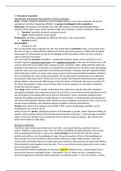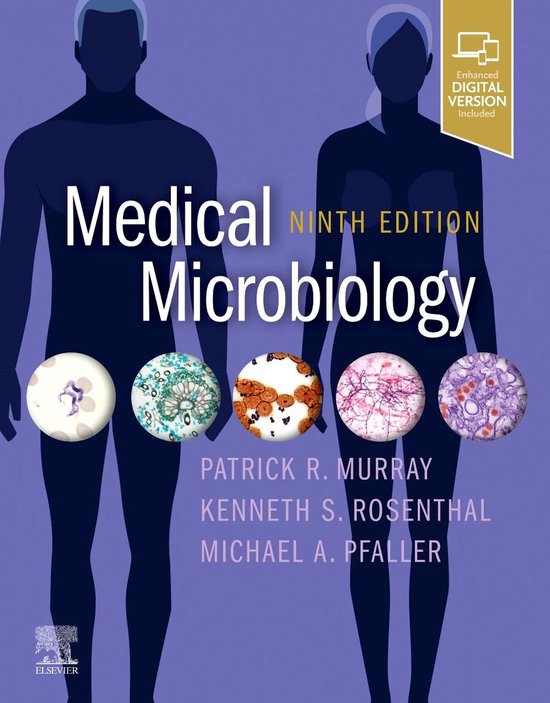1. From prion to parasite
Classification and general characteristics of micro-organisms
Prion = protein, related to Alzheimer’s and Creutzfelt-Jacobs. Is not a micro-organism. Viruses for
example are not micro-organisms officially. So groups of pathogenic micro-organisms:
Eukaryotes, like humans and animals, have cells with nucleus, envelope (phospholipid bilayer
(animal), chitin (rigid, fungi), sterols (animal, fungi), mito, lysosome, nuclear membrane, ribosomes.
Parasites: helminths (multicel), protozoa (unicel)
Fungi: mould (multicel), yeast (unicel)
Prokaryotes, envelope, peptidoglycan, different ribosomes, rest is not present:
Bacteria (unicel)
Not classified:
Viruses (no cell).
We can also divide micro-organisms by size. We cannot look at helminths under a microscope since
they are too big, so visible with the naked eye (0,2mm). Rest of the groups ar visible with an optical
microscope (0,2 micrometer) except for the viruses (o,002 micrometer) which we have to look at
with an electron microscope.
Let’s start with the parasites. Parasitism = relationship between species where one lives on or in
another organism causing it some harm and is adapted structurally to this way of life (they have a life
cycle of which the human body/other organism is part). Helminths: often visible with the naked eye.
Example is the tapeworm in intestines or roundworms. Roundworms we can find in more developing
countries, they can cause obstruction and intestine perforation. Protozoa: example is giardia lamblia
which looks like a smiley, we need a microscope to see it and it causes intestinal problems. Malaria is
also an important one, even smaller then giardia. We see blue spots in erythrocytes as trophozoite.
Do parasites really cause harm? Maybe not, we see studies that helminth infections protect against
allergy/asthma, autoimmunity, IBD because of the interaction of helminth with immune system. On
the other hand people in those areas will have lower immune response in vaccination, helminths
temper the immune system.
Then fungi, which consist of moulds: multicellular they replicate by mycelia (threads), example is
aspergillus furmigatus most important mould. We can find it in environment (food, agriculture) and it
can be dangerous for people with severe immune depression. Yeasts: unicellular organisms that
replicate by budding, example is candida albicans (5 micrometer). In immunosurpressed patients we
see severe disseminated infections with moulds and yeast, dangerous and hard to treat. In the GP we
see less severe infections: skin infections/thrush (candida in mouth)/nail infections.
Viruses need a host cell to replicate can be DNA or RNA, can be capsid shape classified, can be
enveloped or not, can be ss or ds.
Lastly we have the prions, pathogenic proteins. Transmissable or genetic. Induce abnormal folding of
specific cellular proteins (prion proteins) abundantly present in the brain -> brain damage Creutzfeld-
Jakob. In the early 90 there was an outbreak of this in the UK ‘mad cow disease’. We cannot treat
well, hard to detect in early stage.
Bacteria classification
Classify on: optic microscopy (shape (cocci and rods), color (gram staining), position (cluster or
chain)). Position is important in cocci. Then we look at metabolism aerobic/anaerobic. We can also
look at pathogenicity but this is a grey area. Gram staining has to do with the cell wall. A gram
positive cell wall has a lot of peptidoglycan layer, the gram negative cell has a thin peptidoglycan
layer and then an outer membrane. We put body material on a glass, fixate bacteria, stain with
crystal violet, treat with iodine (so crystal violet stays inside the cells) and then we wash with ethanol
(decolorization), gram negative loose the stain. Then we do safranin counterstain which can be taken
up by clean gram negatives.
Some important bacterial pathogens for humans: table PPT. Diplococci are s. pneumoniae (chain +,
pneumonia) neisseiria meningitis (chain -, meningitis). Cocci in chains are also s. pyogenes (very
severe damage/wound infection ‘flesh eating bug’ necrotizing fasciitis, +). Cocci in clusters s. aureus
,(+, abscess). Rod square ends: bacillus clostridium (+, food intoxication (perfringens) or tetanus
(tetani)), e. coli (-, UTI) are often found in the intestines. Comma shaped rod: vibrio cholerae (-). Rod
s-shaped: campylobacter (-) diarrhoea.
Why does one not cause all? Related to preferred locations and environment.
Streptococcus pyogenes can cause necrotizing fasciitis within minutes over one body part and it can
expand quickly and has a very high mortality. We treat with antibiotics straight away and surgery to
remove all infected parts. pictures PPT: cocci in chains (are always streptococci). cocci in clusters
(staphylococcus). s-shaped gram – rods (campylobacter). There are also some spiral bacteria (borrelia
burgdorferi, treponema pallidum: syphylis). gram + diplococci (strep pneumoniae).
Then the metabolism, aerobic means that bacteria cannot grow in the absence of oxygen
(pseudomonas aeruginosa). Anaerobes do not tolerate oxygen so found in the gut (clostridium
perfringens) or in the dental pockets of the mouth. However majority of bacteria are facultative
aerobe/anaerobe (e.coli) which can grow in both circumstanes. Then there are some very specific
capnophilic or microacrophilic with a spec. amount of oxygen needed.
There are always some exceptions to the rule. We can bacteria atypical if we cannot stain them with
the gram stain. Ex mycoplasma do not have a cell wall. Chlamydophyla pneumonia and chlamydia
trachomatis do have a cell wall but they are living obligately intracellular (stain cannot get to the
bacteria since they are in a human cell).
Commensal flora
90% of cells in our body are bacteria. Pathogenicity of them is a result of host-guest interaction
imbalance.: immunosurpression, age, cathethers, antibiotics. Most infections are caused by human
commensals so if we know which is where we know which pathogens we can expect in which site.
We do not have flora in blood, organs and bladder/kidneys. We do have flora on skin, intestinal tract,
urogenital tract, respiratory tract. They: stimulate immune system, metabolism, protection.
Remember bacteria we just talked about? We can find them in the body. Even strep. pyogenes can
be found in the nasopharynx. Diversity of species and amount of bacteria increase if we go down in
the intestinal tract
What is a primary pathogen? can cause disease in healthy individuals (salmonella, influenza, s.
aureus, s. pyogenes), this also includes open wound infections. Then we have opportunistic
pathogens which can cause disease if local or general weakness in host defense like foreign material
in the body or immunosurpressed (s. epidermis, pneumocystitis carnii). Most infections are caused
by human commensal flora which contains primary and opportunistic pathogens.
Bacteria pathogenesis
Pathogenesis of bacterial disease starts with transmission which amounts to how we can acquire
them: ingestion, inhalation, direct skin contact. There is also another way to classify transmission by
the initial source they come from. Ex. chicken pox (varicella zoster) or myco TB from human to
human. Then there is animal to human (zoönosis) camplyobacter, coxiella burnetti (Q fever,
pneumonia), eating meat which is infected for example. We also can have environment to human
(legionella pneumophila) ‘when you don’t use your shower for a long time’, happens in hotels, sauna
etc. legionella does not colonize. Normally the bacteria are able to colonize: adherence, evasion of
host defense and this phase has no symptoms. Then the infection could arise with tissue invasion,
toxin production which both cause symptoms of an infection. Main symptoms of infection: redness,
swelling, heat (fever), pain.
Virulence factors are things that make causing disease more likely: toxins, pilus, glycocalyx, capsule.
More virulence factors means a higher pathogenicity. Gram – generally have lipopolysaccharides
(endotoxins on outside of the bacterium cause inflammation and shock) in neisseria. Pilus (fimbria) is
a protien that helps with adherence/attachment and conjungation (sex pili) in e. coli for example.
,Capsule (sugar) helps with attachment and protects against phagocytosis like in s. pneumoniae. SPE’s
strep pyogenes exotoxins (protein) cause rash and shock.
Diagnostics
Body material which we need for UTI?
1. Urine, gram staining within an hour, optical microscopy short time because we do not need
to culture etc.
2. Culture on agar plates to get colonies and to determine what they look like, to get this we
put it in oven 35 degrees for 1 day.
3. Antibiogram: test to which antibiotics the bacteria will respond. There are several techniques
all based on culture, takes 2 days.
Body material for STD?
1. Swab or genital discharge, remember majority is gonorrhoea or chlamydia (cannot culture
intracellular), so we do PCR
2. Blood sample, HIV antibodies, syphilis-antibodies.
Body material for malaria?
1. Blood as a whole, malaria staining
2. Blood antigen detection (products of the protozoa)
So we ook at: organism itself (UTI), antibodies against it (lyme), products of it (pneumonia), DNA/RNA
of micro-organism (chlamydia). For bacteria we use all of classes of diagnostics depending on what
we suspect. For viral diagnostics we can use antibodies (EBV/Pfeiffer), products (HIV envelope), PCR
(influenza), organism itself (culture virus within human cell line, not common). For parasites we can
use all four classes organism (helminth), antibodies (schistosoma: female within male laying eggs in
intestines). Fungi are mainly detected by culture and aspirgilis can also be detected by antigen.
Looking into the organism itself was first done by Antoni van Leeuwenhoek 1632-1723. We use body
material, fast (minutes), different stains (gram, zeihl-neelsen auramin, blancophor) use for different
classes of organisms. Culture in solid or liquid media and takes time (days). After culture we do
identification and then we do antimicrobial susceptibility: E-test (fancy way: antibiotics on strip from
low to high concentrations and we can see until where the bacteria grow), disc diffusion (bacteria
free zone around the disc), broth dilution method (bacteria grow in liquid media in different
concentrations of antibiotics, nowadays we use automated systems for that, still it needs culturing
before).
Looking for DNA/RNA material by PCR is recent by 1983 Kary Mulis. Can also be automated. If we
compare with culture + fast, sensitive also for dead bacteria, option for non culturable bacteria and
viruses BUT – no quantification, sensitive to contamination, targeted vs. open, non antibiotic
susceptibility testing, more expensive.
Detection of antibodies compared to PCR + lifelong immunological scar, cheaper BUT – not suitable
for acute infection beause it takes time to make them, cross reactivity (antibodies agains other virus
than we think.
Product detection put some body material on test strip and we see band or no band (antigen of
legionella, pneumococcus, malaria or toxin of clostridium, EHEC). + positive result is very good –
negative result does not mean it is not there.
Summary in PPT for exam.
, Gram Postive Cocci
Staphylococcus Staph. aureus/ epdiermis/ saprophyticus
MSSA
MRSA
Streptococcus Strep pneumoniae
Strep pyogenes (Group A)
Strep agalacticae (Group B)
Strep viridans
Strep Bovis (Group D)
Enterococci E. faecalis (Group D strep)
Gram Positive Bacilli
Spore Forming Bacillus anthracis/ cereus
Clostridium tetani/ botulinum/ perfringens/ difficile
Non-Spore Forming Corynebacterium diphtheriae
Listeria monocytogenes
Gram Negative Cocci
Neisseria Neisseria meningitidis
Neisseria gonorrhoeae
Gram Negative Bacilli
Enterics Escherichia coli
Salmonella typhi/ enteridis
Shigella dysenteriae
Klebsiella pneumoniae
Serratia
Proteus
Campylobacter jejuni
Vibrio cholerae
Vibrio parahaemolyticus/vulnificus
Helicobacter pylori
Pseudomonas aeruginosa
Bacteroides fragilis
Respiratory bacilli Haemophilus influenzae
Haemophilius ducreyi
Bordatella pertussis
Zoonotic bacilli Yersinia enterocolitica
Yersinia pestis
Brucella
Francisella tularensis
Pasteurella multocida
Bartonella henselae
Other Gardnerella vaginalis
Other Bacteria
Mycobacteria Mycobacterium tuberculosis
Mycobacterium leprae
MOTTS
Spirochetes Borrelia burgdorferi
Leptospira interrogans
Treponema pallidum
Chlamydiaceae Chlamydia trachomatis
Chlamydophila
Rickettsia
Ehrlichia
Mycoplasmataceae Mycoplasma pneumoniae
Ureaplasma urealyticum
Fungus-like Bacteria Actinomyces israelii
Nocardia





